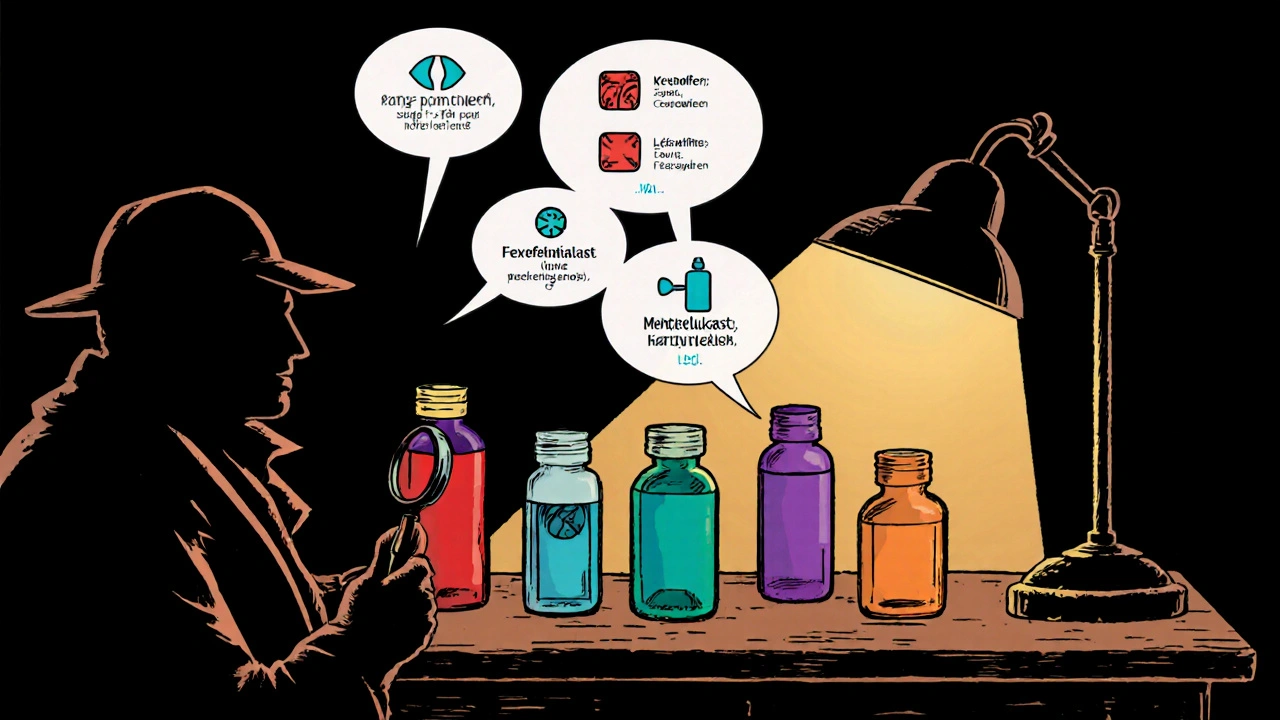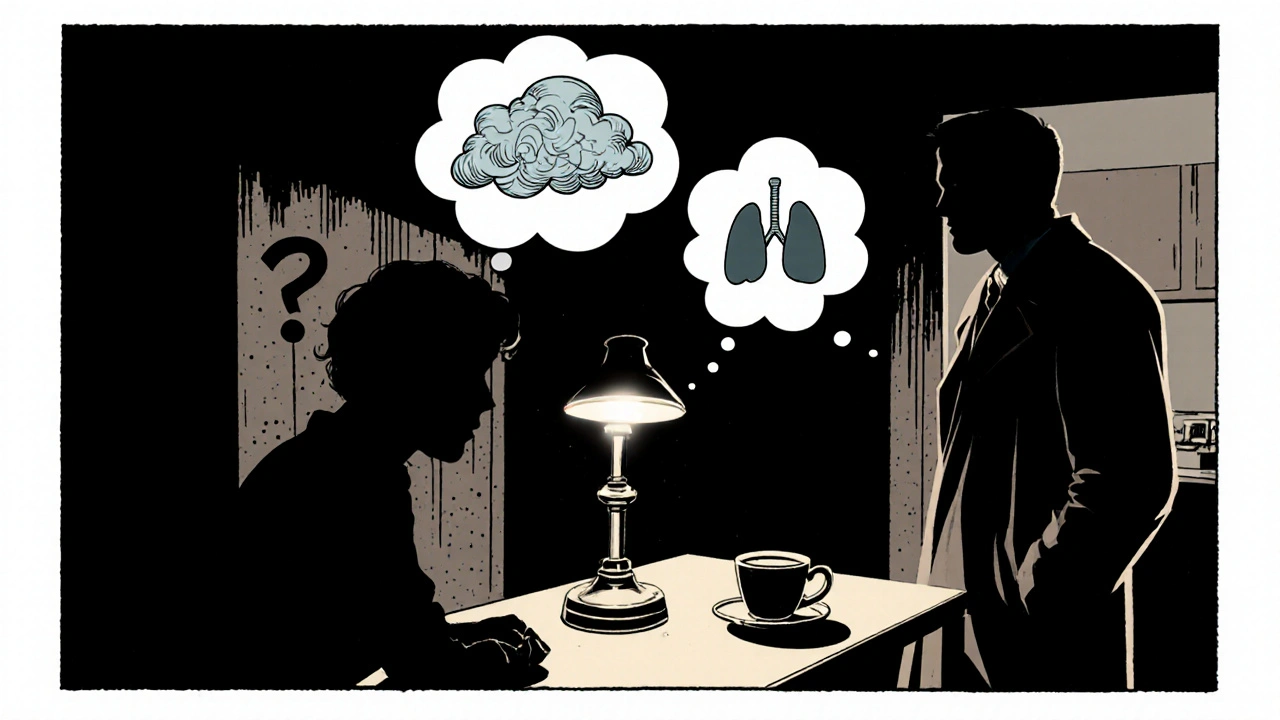Allergy Medication Selector
This tool helps you choose the most appropriate allergy medication based on your specific symptoms, lifestyle needs, and safety considerations. Simply answer the questions below to get a personalized recommendation.
Your Allergy Profile
When you’re dealing with sneezing, itchy eyes, or asthma flare‑ups, picking the right antihistamine can feel like a gamble. Ketotifen often shows up on pharmacy shelves, but dozens of other options exist, each with its own quirks. This guide breaks down how Ketotifen stacks up against the most common alternatives, so you can decide which pill (or syrup) fits your symptoms, lifestyle, and safety needs.
What Is Ketotifen?
Ketotifen is a first‑generation antihistamine that also stabilises mast cells, preventing them from releasing histamine and other inflammatory mediators. It was originally launched in the 1970s for asthma prophylaxis, but today it’s widely used for allergic rhinitis, conjunctivitis, and chronic urticaria. In the UK, it’s available by prescription as tablets (often 1mg) and as an eye‑drop formulation for seasonal eye allergies.
How Does Ketotifen Work?
The drug blocks the H1 receptor, the primary binding site for histamine on cells that cause itching, swelling, and mucus production. At the same time, it hinders mast cells from degranulating, which means it can reduce the overall inflammatory cascade, not just the histamine spike. This dual action explains why some patients experience longer relief compared with pure H1 blockers.
Key Alternatives to Consider
Modern allergy treatment leans heavily on second‑generation antihistamines, which aim to minimise drowsiness while keeping efficacy high. Below are the four most frequently prescribed alternatives.
- Loratadine - a non‑sedating H1 blocker popular for seasonal allergies and hives.
- Cetirizine - slightly more potent than loratadine, with a quick onset but a low‑to‑moderate sedation risk.
- Fexofenadine - the least sedating of the group, often chosen for daytime use.
- Montelukast - a leukotriene receptor antagonist that isn’t an antihistamine but helps with asthma and allergic rhinitis.

Comparison Table: Ketotifen vs the Big Four
| Medication | Class | Typical Dose (adult) | Onset of Relief | Duration | Common Side Effects | Pregnancy Category (UK) |
|---|---|---|---|---|---|---|
| Ketotifen | First‑gen H1 blocker + mast‑cell stabiliser | 1mg once daily (tablet) | 30‑60min | 12‑24h | Drowsiness, dry mouth, weight gain | B (use only if clearly needed) |
| Loratadine | Second‑gen H1 blocker | 10mg once daily | 1‑2h | 24h | Headache, mild fatigue | A |
| Cetirizine | Second‑gen H1 blocker | 10mg once daily | 30‑60min | 24h | Drowsiness (higher than loratadine), dry mouth | A |
| Fexofenadine | Second‑gen H1 blocker | 180mg once daily | 1‑2h | 24h | Headache, nausea | A |
| Montelukast | Leukotriene receptor antagonist | 10mg once daily (asthma) or 5mg (allergy) | 2‑4h | 24h | Sleep disturbances, abdominal pain | B |
Choosing the Right Antihistamine for You
Deciding whether Ketotifen or an alternative is best depends on three practical factors: symptom profile, lifestyle demands, and safety considerations.
- Symptom profile: If you have both allergic rhinitis and occasional asthma, Ketotifen’s mast‑cell stabilising effect can curb both, while a pure H1 blocker only tackles histamine‑driven symptoms.
- Day‑time alertness: For students, drivers, or night‑shift workers, the non‑sedating second‑generation options (Loratadine, Fexofenadine) are usually safer.
- Safety & pregnancy: Women who are pregnant or planning pregnancy often prefer Category‑A antihistamines like Loratadine or Cetirizine. Ketotifen’s Category‑B label means it’s only used when benefits outweigh potential risks.
Age also matters. Children under six typically get a lower dose of Cetirizine or a pediatric formulation of Montelukast, while Ketotifen isn’t commonly prescribed for that age group in the UK.

Potential Side Effects and When to Seek Help
All antihistamines carry some risk. Here’s a quick cheat‑sheet of red‑flag symptoms you shouldn’t ignore.
- Excessive drowsiness or confusion - especially with Ketotifen or Cetirizine; avoid operating machinery.
- Rapid heartbeat, palpitations - rare but reported with high‑dose Ketotifen; contact a GP.
- Severe skin rash or swelling - could signal an allergic reaction to the drug itself; seek emergency care.
- Persistent gastrointestinal upset - may indicate intolerance; consider switching to a non‑sedating alternative.
Keep an eye on drug interactions. Ketotifen can increase the effects of CNS depressants (e.g., alcohol, benzodiazepines). Montelukast may interact with certain antibiotics and antifungals.
Practical Tips for Getting the Most Out of Your Antihistamine
- Take the medication at the same time each day to maintain steady blood levels.
- If drowsiness is a problem, try the dose at night or switch to a non‑sedating alternative.
- Combine with nasal saline rinses for added relief in allergic rhinitis.
- Store tablets in a cool, dry place; eye‑drops should be refrigerated after opening.
- Never double‑dose to “catch up” on missed pills - it raises side‑effect risk.
Frequently Asked Questions
Can I use Ketotifen for seasonal allergies?
Yes. While Ketotifen was originally marketed for asthma, its antihistamine and mast‑cell stabilising properties make it effective for hay‑fever, allergic conjunctivitis, and chronic hives.
Is Ketotifen more sedating than newer antihistamines?
Generally, yes. Ketotifen belongs to the first‑generation class, which penetrates the brain more readily, leading to drowsiness in up to 30% of users. Loratadine, Fexofenadine and Montelukast have much lower sedation rates.
Can I take Ketotifen with other allergy meds?
Combining two antihistamines rarely adds benefit and can increase side‑effects. However, pairing Ketotifen with a nasal corticosteroid (e.g., fluticasone) is common and safe for persistent rhinitis.
Is Ketotifen suitable for children?
In the UK, Ketotifen is not typically prescribed for children under six. For younger patients, Cetirizine or a pediatric formulation of Montelukast is preferred.
What should I do if I miss a dose?
Take the missed tablet as soon as you remember, unless it’s almost time for the next dose. In that case, skip the missed one and resume your regular schedule - don’t double‑dose.
Bottom line: Ketotifen offers a unique double‑action that can be a game‑changer for patients juggling allergies and mild asthma, but the trade‑off is sedation and a stricter pregnancy label. For most day‑time allergy sufferers, a second‑generation antihistamine like Loratadine or Fexofenadine delivers relief with fewer side effects. Talk to your GP or pharmacist, weigh the pros and cons listed above, and you’ll land on the right choice for your health.


Comments
namrata srivastava
One must appreciate the ontological stratification inherent in first‑generation antihistamines such as Ketotifen; its bifunctional mechanism-simultaneous H1 antagonism coupled with mast‑cell stabilization-constitutes a paradigmatic exemplar of polypharmacology, thereby engendering a prolonged therapeutic window that supersedes the mono‑modal action of second‑generation agents.
On October 16, 2025 AT 17:51
Priyanka arya
Oh yeah, and the pharma giants don’t want you to know that they’re secretly sprinkling micro‑chips in the tablets to track our sneezes 😱🔬. Keep your eyes peeled, because every “new formula” could be a covert surveillance upgrade 🤯👁️.
On October 20, 2025 AT 15:28
Loren Kleinman
When I think about choosing an allergy medicine, I try to keep the decision as clear as possible. The first thing I consider is what symptoms are bothering me the most. If it is just a runny nose and itchy eyes, a non‑sedating antihistamine often does the trick. However, when I also have mild asthma, I look for a drug that does more than just block histamine. Ketotifen’s ability to stabilize mast cells means it can help with both the nasal symptoms and the bronchial hyper‑responsiveness. This dual action is something you won’t find in loratadine or fexofenadine. On the other hand, the sedation that comes with Ketotifen can be a real drawback, especially if you need to drive or operate machinery. I have found that taking the dose at night can mitigate the drowsiness while still providing daytime relief. It is also important to think about drug interactions; combining Ketotifen with alcohol or other central nervous system depressants can amplify the sleepy feeling. In my experience, the cost of Ketotieve is comparable to other generic antihistamines, so price isn’t a major factor. For pregnant women, the Category‑B classification means you should discuss the risks with your doctor before starting. Children under six are generally not prescribed Ketotifen, so pediatric options are limited. If you are looking for a medication that won’t make you feel groggy, a second‑generation antihistamine like cetirizine may be preferable. Ultimately, the best choice depends on a balance between efficacy, side‑effect profile, and your personal lifestyle demands. I always recommend keeping a symptom diary for a week to see which drug gives the most consistent relief. In summary, Ketotifen can be a game‑changer for combined allergy and asthma control, but it is not without its trade‑offs.
On October 24, 2025 AT 13:05
Sabrina Goethals
Wow, the table's so neat, the data's clear, and honestly, I'm just sipping my tea, lol.
On October 28, 2025 AT 10:41
Jenny Spurllock
I noticed that the onset time for cetirizine is quite comparable to ketotifen, which could be useful for people who need quick relief. Its side‑effect profile is also milder for many users.
On November 1, 2025 AT 08:18
Amanda Joseph
Sure, because who doesn't love feeling like a ozombie at midnight after a cute little dose of Ketotifen? 🙄
On November 5, 2025 AT 05:55
Kevin Aniston
Hey, I get where you're coming from, and it's absolutely valid to prioritize clear-headedness during the day. If sedation is a deal‑breaker, consider trialing a low‑dose of loratadine in the morning and see how you feel after a few days. Many users report that adjusting the timing-taking the antihistamine right before bedtime-can preserve daytime alertness while still managing nighttime symptoms. Also, pairing the medication with a saline rinse can reduce overall allergen load, potentially allowing you to lower the drug dose. Remember, the goal is to find a regimen that meshes with your lifestyle, not to force yourself into a one‑size‑fits‑all solution.
On November 9, 2025 AT 03:31
Karen Wolsey
Alright folks, if you want to stay awake for the next three hours, just grab that first‑gen antihistamine and let the world become a blur-nothing says “I love life” like a mid‑day nap triggered by your allergy meds.
On November 13, 2025 AT 01:08
Melissa H.
Let’s cut the fluff: if you’re not willing to tolerate drowsiness, steer clear of ketotifen and pick a second‑generation option. 👍
On November 16, 2025 AT 22:45
Edmond Abdou
Everyone’s experience varies, so I encourage you to keep a journal of how each medication affects your energy and symptoms; sharing that data can help the community make better choices 😊.
On November 20, 2025 AT 20:21
Sydnie Baker
One must unequivocally acknowledge the lexical imprecision pervading lay discussions of antihistaminic therapeutics; the demarcation between “first‑generation” and “second‑generation” is not merely chronological but signifies a profound shift in receptor selectivity, blood‑brain barrier permeability, and consequently, iatrogenic somnolence.
On November 24, 2025 AT 17:58
Benjie Gillam
Okay, quick rundown: ketotifen blocks H1 and stops mast cells from spilling their inflammatory guts, which is great for combo allergy‑asthma cases, but expect some drowsy feels. If you’re a driver or need to stay sharp, fexofenadine or loratadine are cleaner picks, and they’re cheap too. Also, never mix it with benzos or heavy alcohol, otherwise you’ll feel like wobbly jelly. And remember to store the eye‑drops cool, not in the hot car trunk.
On November 28, 2025 AT 15:35